Recently I have felt that the international field of contemporary art and exhibition practices have taken on questions and urgencies such as the climate crisis as a mandate to produce a vast number of large-scale group exhibitions and discourses about the Anthropocene or post-humanism as an archetypal symbol of our time and contemporaneity. There is a stream of exhibition and biennial projects addressing art in an age of the Anthropocene or emphasising art dealing with post-anthropocentric understandings of the world. These discourses seem to be something that every credible art institution must foster to stay relevant.
This development is, of course, part of the political debate that attempts to move the current emphasis towards urgencies and threats that the middle class around the westernised world feel most dire. So, the question arises: what is the role of art institutions, curatorial praxis, and exhibition-making in this situation?
In many cases, the answer seems to be that audiences need to experience the contemporary artistic practices that either represent clear reactions to the Anthropocene such as art which speculates on “new” relations between “human” and “nature” or institutions which show far-reaching surveys of work done within notions of post-human conditions. However, rarely anthropocentric or post-human concepts are practised in other areas of institutional activities other than picking up thematic frameworks for exhibitions. For example, seldom asked are questions around how an institution or exhibition should produce knowledge, or how an exhibition display engages with different audiences in an era of the Anthropocene.
As to addressing the climate crisis and crises caused by human agency and western thought, there is a need for exhibition methodology which handles much more complex and intersectional approaches than the current representational and politically reductive modes of presenting artworks, research, or critical discourses. In many cases, these models reduce the meanings of artworks and artistic research (which contain complex processes of experimentation and exploration, references to multidisciplinary theoretical conversations, and multivocal political debates) to discourses which highlight the most straightforward, and populistic aspects of the works.
Perhaps one of the most notable attempts to develop exhibition practices which utilise the complexity of versatile references, different knowledges, multidisciplinary artistic work, and diversity of critical thinking has been seen within recent years at Haus Der Kulturen Der Welt in Berlin — an art institution which brought the term Anthropocene into the field of contemporary art. Multiple essay-exhibitions and research strands within The Anthropocene project and their other programing such as Forensis speculated whether different areas of thought and implementation (which are typically categorized as specialized research practices or as different ways of understanding artistic modes) should be regarded together. Further claims seem to suggest that this complexity produces knowledges and experiences which can relate in meaningful ways to complexities of the Anthropocene and other great urgencies of the contemporary world.
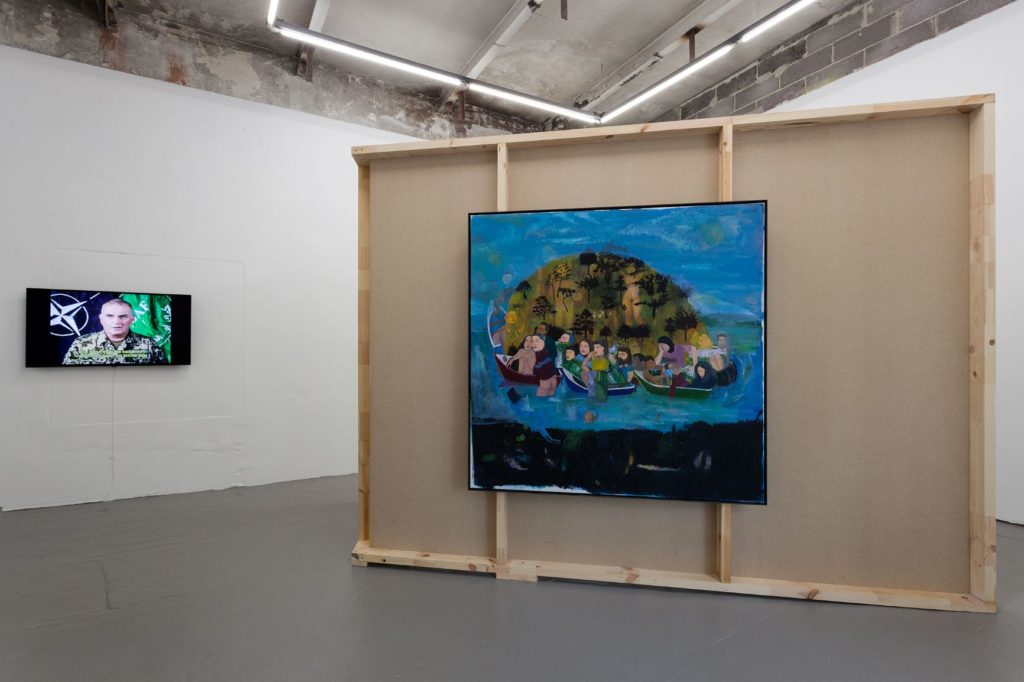
With this in mind, I approached the exhibition When You Say We Belong To The Light We Belong To The Thunder curated by Heidi Ballet (who has been working earlier at Haus Der Kulturen Der Welt) at Contemporary Art Museum of Estonia (EKKM). The exhibition moves beyond only stating that this is the art which expresses the current conditions of climate crises and destructive capitalism to a more speculative proposition. It puts forward a proposal: maybe the rise of nationalism, neo-fascism, and climate crises are linked. Does belonging to the land, and empathy for non-human inhabitants become more relevant and meaningful when effects of the climate emergency and destructive capitalism threaten on an individual level? Curator Heidi Ballet quoting Bruno Latour, in her curatorial essay, elucidates on this proposition: “The wealthy flee to their offshore heavens, the common people head for the nation-state of yesteryear”.
The exhibition uses artworks and research contributions to hint at versatile poetics and didactic ways that this might be possible. It unfolds within three floors of EKKM’s space. The first floor emphasises the human’s emotional relation towards animals and land — a narrative beginning with the installation Short Story by artist Edith Karlson. It presents the skeleton of a seal found from the Baltic Sea’s shoreline and a sculptural form of a plastic costume or human shell. Life escapes from both the animal and the human—what is left behind are merely bones and plastic waste. The work O Peixe (The Fish) (2016) by Jonathas de Andrade documents an invented and staged tradition of fishers, of Brazil’s north-eastern coast, giving a last tribute and valediction to the fish before they die as a result of the fisher’s actions.
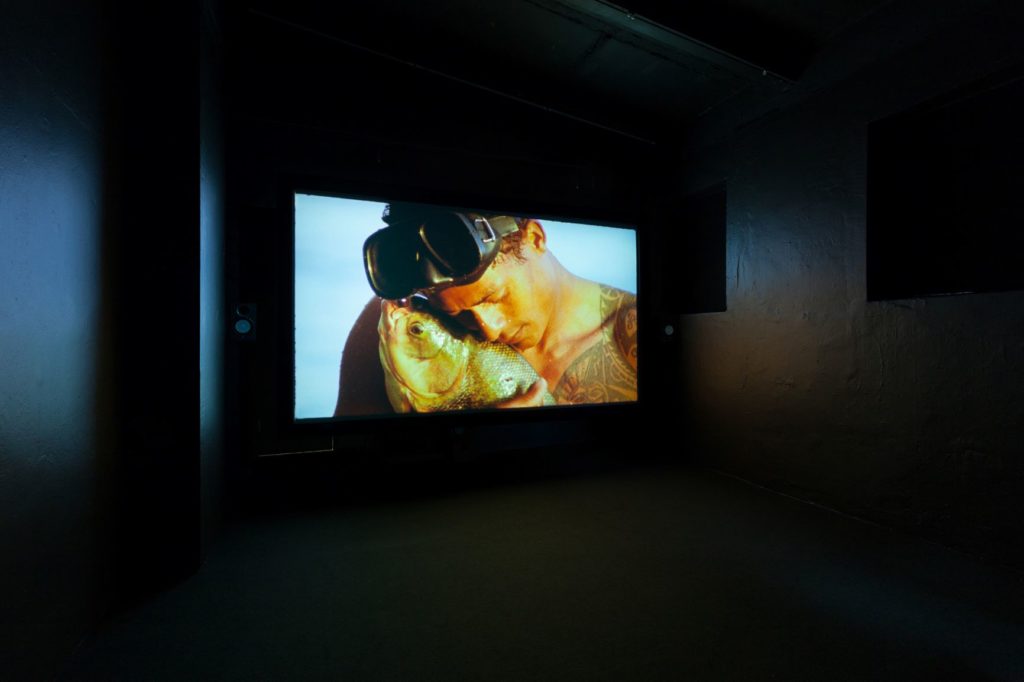
16mm film transferred to 2K video, 37’.
Ballet states in her curatorial essay that the exhibition originated from the curiosity of psychological reactions to climate chaos but the works on the first floor seem to speak more generally about emotions arising from the paradox of material, cultural, and epistemological domination over non-human life and yet, on the other hand, about our species’ deep dependency on other living beings.
The next floor of the exhibition opens up this emotional paradox in the areas of production of historical connections and knowledge. The opening room is covered with wallpaper of forest fires in California. On this backdrop, there are two research displays. One of these displays presents artist Tanel Rander’s fragmented and speculative study on colonialism long before Christopher Columbus in the outskirts of Europe, in the regions now considered Estonia. How we read the history of colonialism from specific situated positions affects our emotions about the contemporary imaginary of land destruction. Bram Demunter’s Returning to John depicts painting as a form of knowledge production from a distance and as an extractive action and demands “a return” to John Constable’s romantic way of representing areas that surround his immediate living environment.
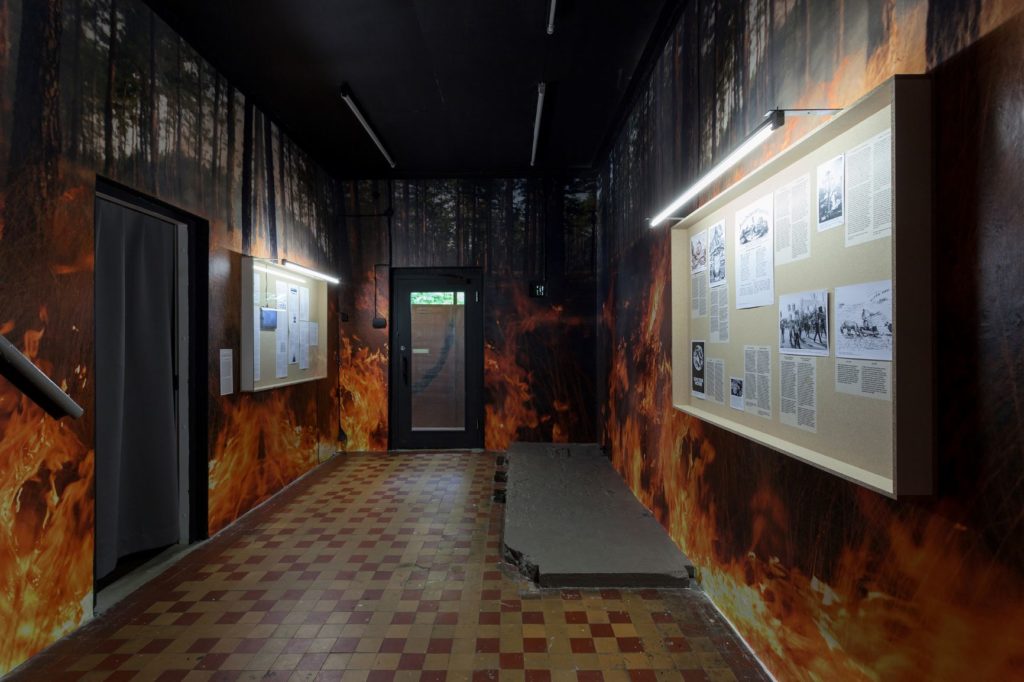
Questions regarding the local and global human connection to the land and environment linger throughout the exhibition. The major pondering, presented here and much more broadly, seems to ask: is there a “progressive” national and emotional belonging that can build up a contemporary sustainable ideological constriction and community for a newly imagined future. One of the research displays named Fragments of Belonging on the second floor of the exhibition presents the history of the environmental campaign that attempted to prevent the opening of a phosphorite mine in the Virunmaa region of Estonia. The events called the Phosphorite War led to the abandonment of the plans and to a nationalistic movement that generated, in the end, Estonia’s independence. Similar eco-nationalism took place in other Eastern European countries as well.
By bringing this kind of knowledge and reading of history alongside emotionality and poetics of artistic contributions, the exhibitions allow new thinking, experiences, and propositions to emerge beyond simple populistic reductions of human activity and nature. The climate emergency requires forms of knowledge-speculation, through exhibition-making, which may suggest connections that institutions of art, scientific research or critical thinking, cannot make by themselves from within autonomous and academic positions which remain rigid.
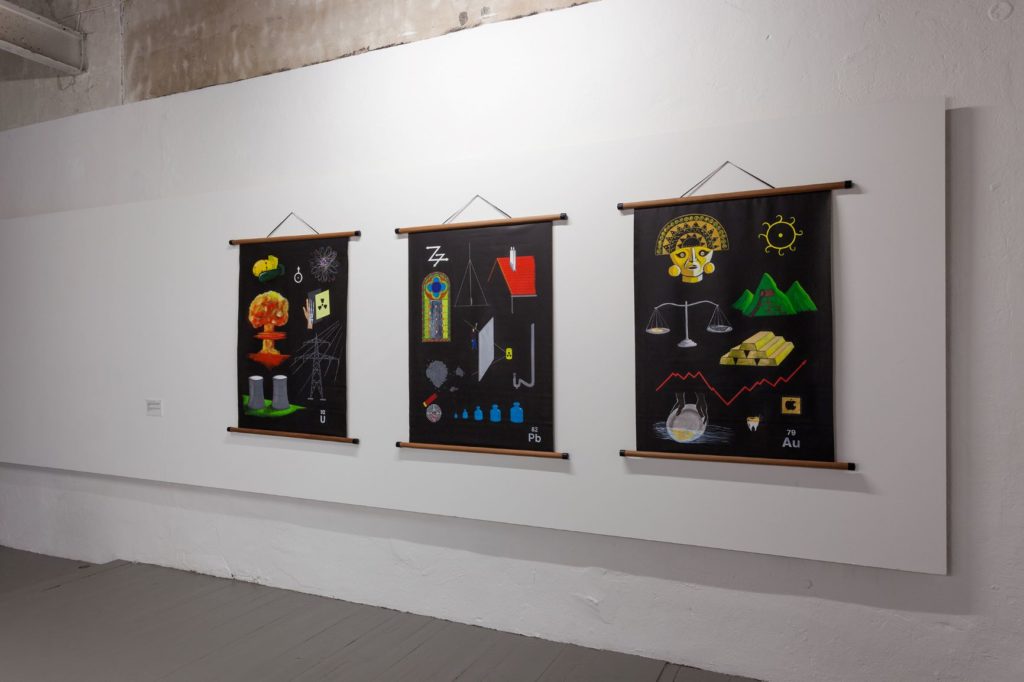
In the fight against simple populism and the commercial appropriation of climate-chaos, we need knowledge production that avoids the pitfalls of reducing the epistemological possibilities of cultural objects and research subjects. This is what the exhibition When You Say We Belong To The Light We Belong To The Thunder attempts to do. This is experienced clearly on the third floor, where the exhibition design by Kaisa Sööt mixes research contributions and artworks in ways more fluid and hybrid.
Works by artist Cian Dayrit and artists Maarten Vanden Eynde & Musasa turn scientific and educational forms such as map-making and information posters into artistic resistance. Cian Dayrit’s embroidery Tree Of Life In The State Of Decay And Rebirth (2019) creates cartography that presents a network of domination linked to land exploitation. Maarten Vanden Eynde & Musasa’s painting series Material Matters (2018-2019) portraits materials that are extracted and traded globally. These paintings produce a more-than-scientific imaginary to highlight the politics of materials and create new forms of educational signage. Research contributions by curator Marika Agu and researcher Francisco Martinez on eastern parts of Estonia turn a collection of postcards and material remains into poetical mediation concerning landscape — land and belonging in relation to an area profoundly affected by the combination of both human activity and natural mutations.

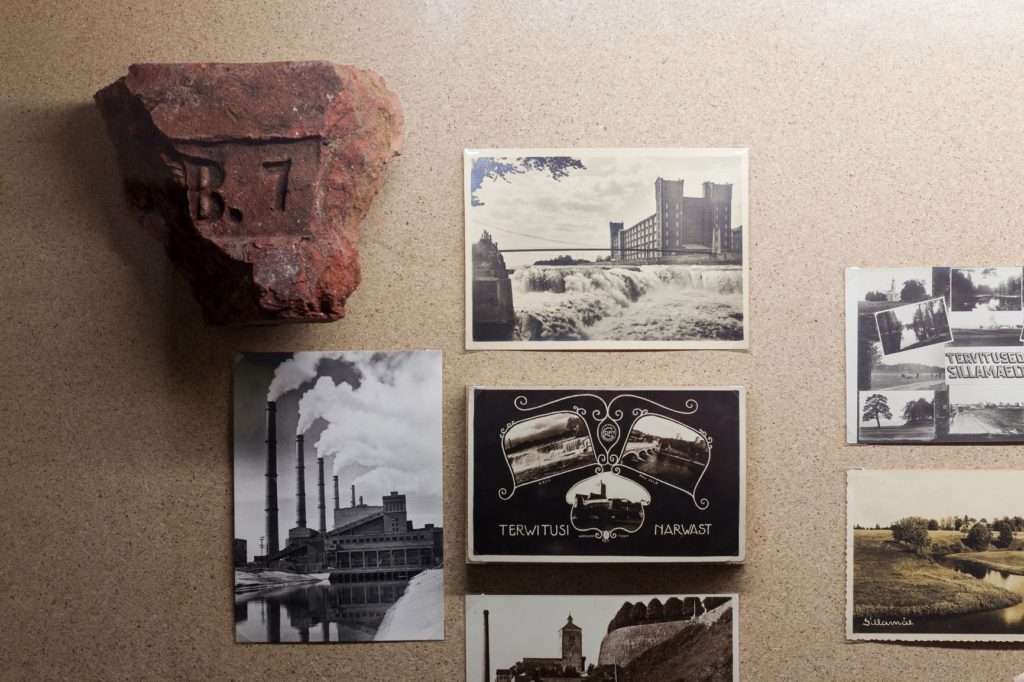
What becomes evident after experiencing the exhibition is that it’s crucial for contemporary art institutions to support and foster long-term projects of curators, institutions, artistic researchers, and practitioners which manage to create new forms of knowledges regarding complex urgencies such as contemporary colonialism, climate chaos, and nationalism. Exhibitions such as When You Say We Belong To The Light We Belong To The Thunder should be only a beginning within a framework of long-term curatorial explorations, not only the result of a one-time exhibition building and research method.
Text: Jussi Koitela
Images: Paul Kuimet / EKKM
When You Say We Belong To The Light We Belong To The Thunder
7 September— 20 October 2019